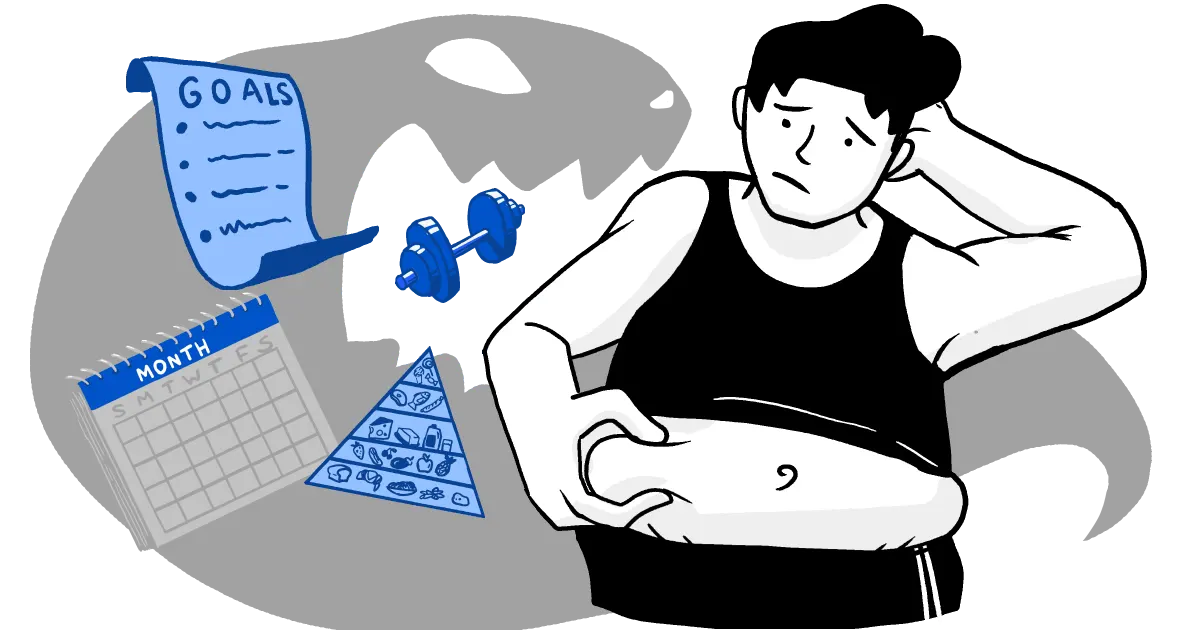
If you have tried eating healthy in the past but have failed, you may feel like there is no way out. Attempting to make smart food choices, start an exercise routine, and saying ‘no’ to your favorite sugary snacks may sound like a pain in the butt — but if you are tired of being fat, getting motivated can help.
Let the lifelong journey of acceptance and higher self esteem begin today.
1. Channel Feelings into Motivation
That fed up feeling you have with your body and your mind, try to let that drive you rather than put you down.
You are fed up because you’re tired of lollygagging, failing, and feeling so-so.
It’s ultimately you versus yourself. You have an idea of what needs to be done, it’s just a matter of getting yourself in the right mindset or headspace to take action. Getting a new perspective on what needs to be done can help be the motivation you need to start your healthy lifestyle.
Motivation is the result of a person’s perception about what happens in life and why, and related to the degree to which someone believes they can control their own life.1 By thinking life and destiny can be controlled, people can increase their ability to use goal-directed behavior and efficacy to improve their belief in their capabilities to change their lives.2
So the more you think you can control your destiny, the more likely you’ll be motivated to make changes or the better.
2. Envision & Plan for Success
Envisioning your future self can be the self-esteem boost needed to start planning for success. Changing your mindset and visualizing your goal is the first step — and is easier than you may think.
Seeing yourself as happy and healthy — both mentally and physically — can be the catalyst for setting both short and long-term goals. Envisioning success provides a direct relationship between episodic future thinking and goal goal achievement.3 Those who complete imagery exercises perform better than those who do not — showing how envisioning success can help with weight loss.4
3. Practice Mindfulness

Even when you’re frustrated with your weight, mindfulness can provide you with the mental and psychological tactics to improve your self-esteem, plan for the future, and achieve your dreams. It can help you envision success, address any limiting beliefs, and see intrusive thoughts for what they are (just another thought that holds no weight).
The effects of mindfulness on psychological health are more interconnected than you may think. Mindfulness is a non judgmental acceptance of one’s moment-to-moment experience to aid against common forms of psychological distress.5
Individuals can use mindfulness tactics to improve their mental health, helping fight against cognitive decline, high blood pressure, low immunity, cell aging, psychological distress and even when striving towards a goal.6
The best way to begin is to start with simple tasks, such as paying attention to the things around you, living in the moment, accepting yourself (flaws and all), and being more present with how your body feels. If this sounds foreign, download the Waking Up app and listen to the intro course for a full breakdown on how to be present.
Incorporating mindfulness into your daily life can help you slow down and find purpose.
4. Do Something About Tired of Being Fat — Do Anything Really
No matter how big or how small, taking action is key because you will never know what works if you don’t try or experiment.
5. Focus on Eating Healthier
Making substitutions in your diet can be the difference maker between weight gain and weight loss. If you are fed up with being fat, finding healthy alternatives for your favorite sugary and fatty foods can reduce empty calories, avoid blood sugar spikes, and curb your hunger pangs with whole foods. So instead of craving cereal, try some of these proven eating tips that can help you make healthier choices.
- Substitute Unhealthy Foods
Small changes you can make in your daily diet include choosing healthier milk alternatives for your coffee instead of using cream, eating leaner meats vs. fatty cuts, snacking on whole foods vs. processed foods, and cutting out sweets after dinner. Not to mention, people tend to ask if fiber brownies are good for weight loss, and while they’re better than normal brownies, whole foods are best.
Switching to eating only healthy fats can also help with weight control so instead of eating red meat, try whole nuts like pecans or almonds instead.7 With small changes, you can lose weight in 7 days and beyond.
- Portion Control
Other small diet changes that can help you with weight loss is to begin with portion control. If you have trouble with stopping eating handfuls of chips after dinner or dozens of cookies, limiting the amount of sweets or unearthly snacks that you consider to be your guilty pleasure can help you cut back on calories and processed ingredients.
- Protein Intake
Many people shed pounds quickly in the initial stages of the keto diet due to water loss. Furthermore, increasing your protein intake and staying hydrated will help reduce hunger cravings that would otherwise cause you to reach for the nearest bowl of chips or wonder if saltine crackers are good for weight loss. Boost your protein intake by eating cottage cheese, lean meats, and yogurt to help you stay full between meals. If you are looking for a meal alternative that contains complex carbohydrates and protein, quinoa is good for weight loss in addition to hemp seeds and chia seeds.
6. Try a New Exercise Routine

Establishing a consistent exercise routine is a key part of the puzzle, even if that means walking, doing yoga, or giving weight lifting a shot. Switching up your exercise routine, or increasing your daily activity level can help you burn more calories. And low intensity exercises will distract yourself from hunger and burn a few calories at the same time.
Whether you’re frustrated with your weight or not, a sustainable exercise program can help you lose weight, gain muscle, and slimming down will boost your self-esteem.
If you have never followed an exercise plan in your life, start with low intensity exercise that is easy on your joints and cardiovascular system, such as swimming or walking. As you get more physically fit and motivated, you can start to switch up your workouts to incorporate strength training, high intensity workouts, running, and other modalities.
Of course, using a well-rounded approach to tackle various areas of fitness, such as flexibility, cardiovascular health, and strength can be a good way to help with weight loss and benefit your body composition.
7. Change Your Mindset
Your mindset is either the bridge or the roadblock between you and weight loss. For those who are sick of being fat, adopting a positive mindset is essential to boosting your self esteem, feeling positive about your progress, and remaining motivated during periods that require mental strength.
As discussed, adopting a mindfulness, meditation program and positive mindset can help us help ourselves. But even changing your internal monolog from “I’m tired of carrying excess weight” to “I’m tired of being overweight, and I’m going to do something about it” can go a long way.8
Check out the book “Awaken The Giant Within” for more constructive ways to change your inner voice and learn how to add affirmations for dream body to your daily routine.
8. Instill Good Habits
The last way individuals can get motivated and lose weight is by changing their habits. Just like learning to wake up on time for work or scheduling a time to clean your apartment, forming healthy diet and exercise habits will go a long way.
Even though weight regain is typical, understanding the factors that can contribute to weight gain helps with long-term management.9 To get there, follow these steps for creating new habits:
- The first way to adopt better habit-making behavior is to identify the harmful habits that were destructive. Identifying and removing harmful habits can be as simple as figuring out what foods in your diet can cause weight gain, the activity level/sedentary lifestyle, or how to substitute foods.
- The second step of changing your behavior is to hold yourself accountable for making the changes in your life and getting rid of harmful habits. If you identify the habits — but don’t do anything about it — this is virtually useless. Take the leap and reap the benefits of your courage.
- The third step of changing poor habits is to remove negative triggers and influences in your life — if friends are bringing you down, find a new set of friends to spend your time with who are encouraging and helpful.
- Lastly, individuals need the willpower and self esteem that they CAN change. Belief is extremely important when it comes to having the confidence to take a leap of faith.
For those who are frustrated with their weight, creating new habits or being consistent can help identify harmful practices and achieve that dream body.
References
1Ewers, Patrick. (2019). The Best, Last Motivation Article You’ll Ever Read: Tactical Tips to Turn Self-Motivation into Habit. Retrieved from <https://betterhumans.pub/the-best-last-motivation-article-youll-ever-read-4-tactical-tips-to-turn-self-motivation-into-2337259472ed[2?gi=7e422da166ce>
2Schunk, D. H. (1990). Introduction to the special section on motivation and efficacy. Journal of Educational Psychology, 82, 3-6. Retrieved from <https://libres.uncg.edu/ir/uncg/f/D_Schunk_Introduction_1990.pdf>
3Sanford, Braden, (2020). Envisioning success: an in depth look at the relationship between episodic future thinking and academic goal achievement. Retrieved from <https://scholar.utc.edu/honors-theses/268/>
4Blankert, T. & Hamstra, M. R. (2017). Imagining Success: Multiple Achievement Goals and the Effectiveness of Imagery. Basic and applied social psychology, 39(1), 60–67. <https://www.tandfonline.com/doi/full/10.1080/01973533.2016.1255947>
5Keng, S. L., Smoski, M. J., & Robins, C. J. (2011). Effects of mindfulness on psychological health: a review of empirical studies.Clinical psychology review, 31(6), 1041–1056. <https://linkinghub.elsevier.com/retrieve/pii/S027273581100081X>
6Suttie, Jill. (2018). Five Ways Mindfulness Meditation Is Good For Your Health. Retrieved from <https://greatergood.berkeley.edu/article/item/five_ways_mindfulness_meditation_is_good_for_your_health>
7Food and Diet. (n.d.). Harvard T.H. Chan School of Public Health. Retrieved from <https://www.hsph.harvard.edu/obesity-prevention-source/obesity-causes/diet-and-weight/>
8Powell, Alvin. (2018). The Harvard Gazette. Retrieved from <https://news.harvard.edu/gazette/story/2018/04/harvard-researchers-study-how-mindfulness-may-change-the-brain-in-depressed-patients/>
9Hall, K. D., & Kahan, S. (2018). Maintenance of Lost Weight and Long-Term Management of Obesity. The Medical clinics of North America, 102(1), 183–197. <https://linkinghub.elsevier.com/retrieve/pii/S0025712517301360>